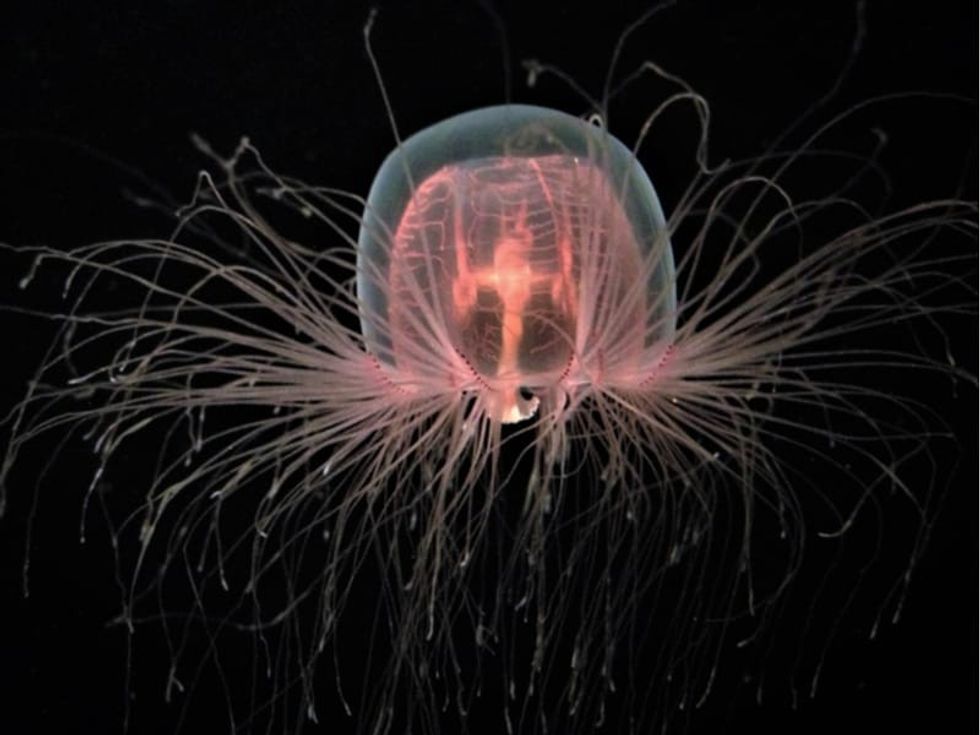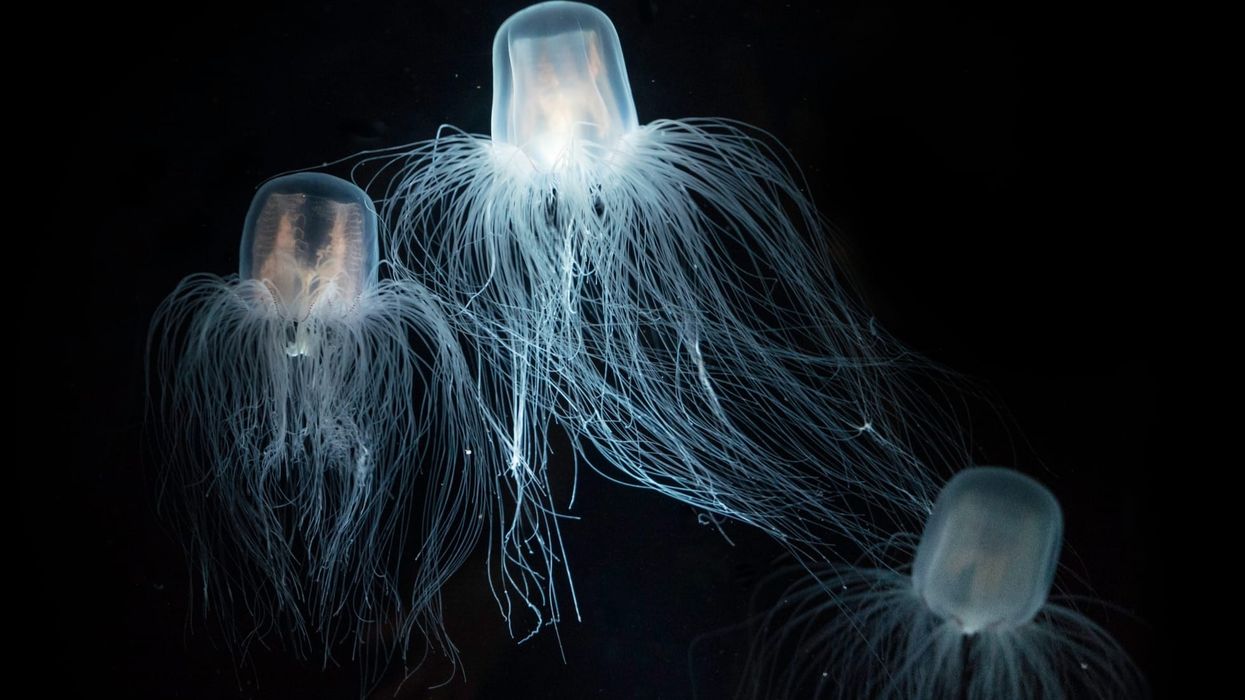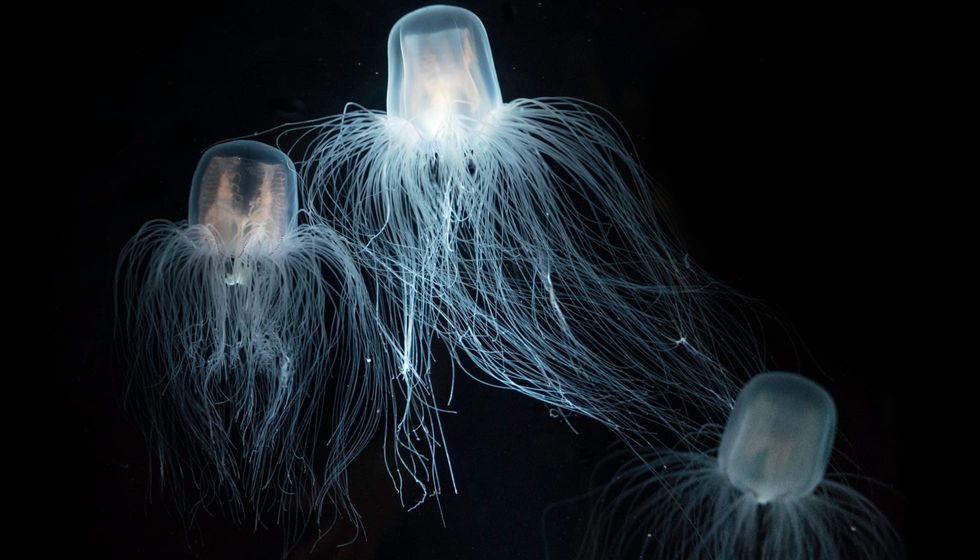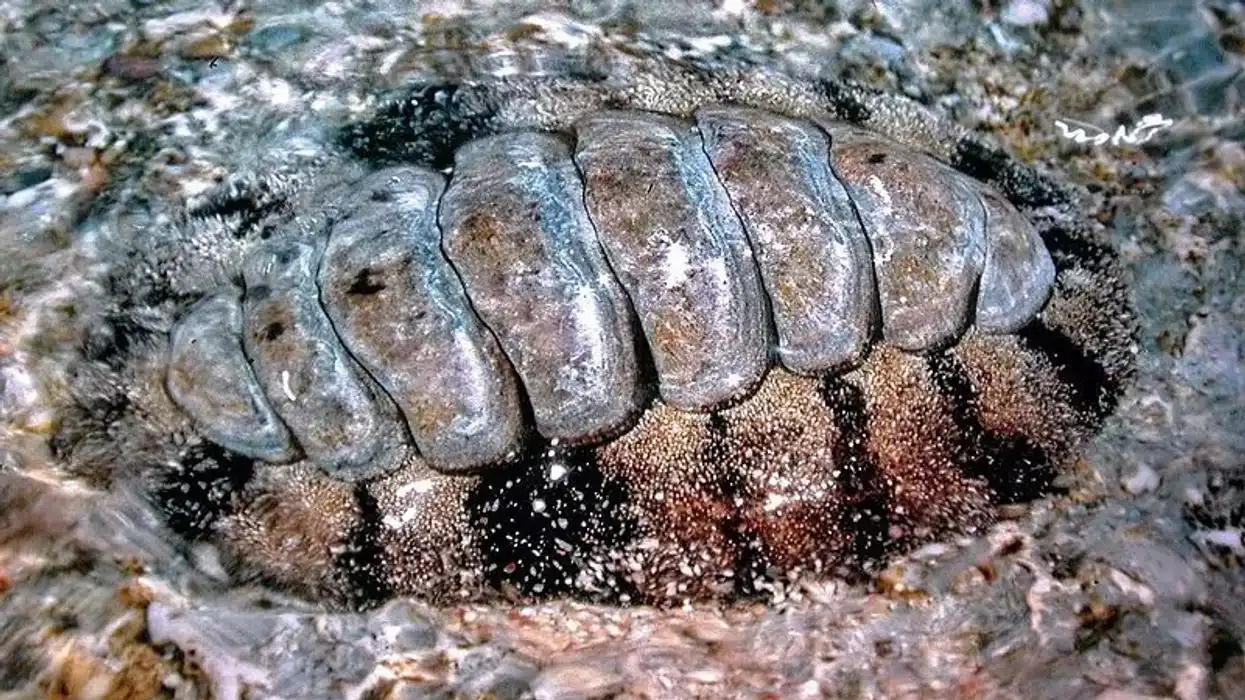Fun Immortal Jellyfish Facts For Kids

A unique species of jellyfish named Immortal Jellyfish, known in the scientific community by the name Turritopsis dohrnii, is one of the very few creatures to possess biological immortality. Originally, from the Pacific, the immortal jellyfish has spread across the world due to a phenomenon known as ballast water discharge.
This jellyfish is typically found in temperate and tropical oceans.
Similar to other jellyfish species. The immortal jellyfish primarily feed on plankton fish eggs and smaller sea creatures, using its tentacles to hunt.
Immortal jellyfish have a variety of predators ranging from other jellyfish species to sharks, and sea turtles.
Due to their similar appearance, they are often mistaken for another jellyfish species known as Turritopsis nutricula. However, a defining characteristic of the immortal jellyfish that sets it apart from Turritopsis nutricula is its ability to restore itself to its birth form when injured.
An adult immortal jellyfish can fully revert to its form at birth and grow into an adult again, a process named transdifferentiation that they can repeat infinite times. Essentially, this means that they are biologically 'immortal', hence their name.
But their immortality doesn't mean invincibility, as they will not survive if eaten by other creatures.
Explore our article further to know more facts about the unique Turritopsis dohrnii. By the end of this article, you will have knowledge about immortal jellyfish lifespan, immortal jellyfish transformation, curious facts about the immortal jellyfish, immortal jellyfish habitat, immortal jellyfish adaptations, immortal jellyfish changing ability, and the immortal jellyfish size.
If you enjoyed this read, be sure to check out more facts on brain coral or freshwater mussels here at Kidadl.
Immortal Jellyfish Interesting Facts
What type of animal is an immortal jellyfish?
Immortal jellyfish, or more scientifically known as Turritopsis dohrnii, is a tiny arthropod belonging to the Oceaniidae family. It is unique in being one of the few creatures to be biologically immortal as it can revert to its polyp form and restart its life cycle whenever it feels threatened.
What class of animal does an immortal jellyfish belong to?
The immortal jellyfish Turritopsis dohrnii is an arthropod that hails from the Animalia kingdom, with its class being Hydrozoa.
How many immortal jellyfish are there in the world?
As of yet, there is no clear cut data that states the exact population of immortal jellyfish. A reason why that is so is due to its near invisible appearance which makes it difficult to discover them.
Another significant reason is its rapid proliferation throughout the world by "hitchhiking" long distance cargo ships. Since they haven't been declared extinct, their population must be relatively abundant.
Where does an immortal jellyfish live?
Immortal jellyfish, also known as the Benjamin Button jellyfish due to its unique regenerative ability, was first discovered in the Mediterranean Sea. Since they were often confused to be Turritopsis nutricula for being anatomically similar, it wasn’t apparent right from the start that they were different species.
After scientists figured out how to spot Turritopsis dohrnii from Turritopsis nutricula, they were discovered more often and have been found in saltwater oceans and coastal areas. It has also been spotted in regions surrounding the country of Japan.
What is an immortal jellyfish's habitat?
Immortal jellyfish inhabit oceans, mainly ones which have temperate or tropical waters. While it prefers warm waters, it has been found in colder regions as well. It is often found on the surface of the oceans or the ocean floor.
Who do immortal jellyfish live with?
Immortal jellyfish has two main stages in its lifetimes: polyp and medusae. It begins its life as a sexually immature polyp.
This stage can be likened to the toddler stage in humans. While in the polyp stage, the singular polyp clones itself and forms a colony named hydroid.
It is capable of creating countless genetically identical clones in the matter of a few days; enough to completely cover the dock of a boat. While staying together in the hydroid colony, those several polyps grow up into medusae that are the more mature form of jellyfishes.
In the medusae stage, they are no longer sexually immature and are capable of engaging in reproductive activities.
Having reached the medusae stage, they leave the colony, become mobile and solitary creatures and go on to reproduce. If they turn out to be successful, it will result in fertilized eggs.
The fertilized eggs will then go on to become a small larvae named planula, which will sink to the ocean floor and stick to a solid surface. After the planula grows into polyps, the cycle continues to once again result in hydroids.
How long does an immortal jellyfish live?
Theoretically, they can live forever and their life cycle will never end, as the immortal bit in their very name suggests.
This is as long as they are not eaten by their natural enemies, they could possibly live on for ages and never die. In the event of an injury, disease or simply put, stress, they revert to one of its earliest forms - a polyp - through a process called transdifferentiation.
Following that process, they begin their new life until they meet with another life threatening event and time turns back for them.
However, there is a catch to their regeneration. If they suffer from starvation or disease in their vulnerable state as a polyp, their regeneration will end at that point and spell their doom.
As long as they safely grow up again from their polyp stage, they can truly life forever and have an indefinite life cycle.
How do they reproduce?
In the reproductive glands, also known as gonads, of the female medusae, eggs are created and developed. When the eggs mature and are ready to be fertilized, they take in the floating sperm in the sea, released by a male medusae.
After being successfully fertilized, the eggs give rise to small larvae called planula. The planula then goes on to settle at the bottom of the ocean and attaches itself to a solid surface such a rock.
As time passes, the planula grows into the immortal jellyfish polyp stage and then creates several clones of itself. The polyp and its clones stay together and that community is referred to as a hydroid.
After several weeks passes, the polyps grow into medusae and lose their sexually immature form. They will then proceed to leave the hydroid to begin reproducing and keep the immortal jellyfish reproduction cycle going.
What is their conservation status?
The immortal jellyfish currently has an abundant population and is found worldwide. Hence, there proves to be no need to take any measures to preserve their species as they are thriving. As of yet, our biologically immortal jellyfish has been deemed as not extinct and the least concern conservation status.
Immortal Jellyfish Fun Facts
What do immortal jellyfish look like?
Immortal jellyfishes are primarily invisible. They have a transparent bell shape, with 90 white tentacles at its exterior, in its adult form.
At the core of the immortal jellyfish is its bright red stomach. Unlike Turritopsis nutricula which is 6.35 mm, adult immortal jellyfishes are 4.5 millimeters across, which means they are smaller than your pinky fingernail. Due to their appearance which is similar to Turritopsis nutricula, they were often mistaken for the other.

How cute are they?
One of the most important immortal jellyfish facts for kids would be regarding their cuteness. Immortal jellyfishes are relatively cute due to their innocent nature.
Being a transparent 'blob' floating across the ocean, they appear harmless. Like most jellyfishes, the immortal jellyfish also looks very squishy as water makes up 95% of their body. However, their cute appearance mustn't fool you as they do sting, though they aren't deadly.
How do they communicate?
The immortal jellyfish doesn't have a brain, similar to most jellyfishes. Therefore, it can't process sensory information and communicate like we do. Existing experiments and research conducted by scientists suggests that jellyfish do not communicate with each other at all.
How big is an immortal jellyfish?
Immortal jellyfishes’ size average around 4.5 mm tall and wide when they are fully grown adults. Young jellyfish will typically be much smaller at 1 mm tall and across.
A typical tuna is a staggering 450 times bigger than the size of an adult immortal jellyfish. Even Turritopsis nutricula, a species it is often confused with, is about 1.5 times bigger.
How fast can an immortal jellyfish move?
Immortal jellyfish is a very slow moving creature. It navigates the vast ocean using its tentacles to push itself forward. As such it is seen gradually pulsing its way to its destination.
How much does an immortal jellyfish weigh?
Though immortal jellyfishes haven't been officially measured in weight, scientists and experts estimate that they weigh just under 500 grams. The immortal jellyfish has 95% water in its body, which contributes heavily to its weight.
What are their male and female names of the species?
There are no separate names for the different genders of this species.
What would you call a baby immortal jellyfish?
A baby immortal jellyfish would be called a planula, a type of larva.
What do they eat?
Immortal jellyfishes mainly feed on zooplankton.
Are they dangerous?
Similar to most jellyfishes, immortal jellyfish can sting us. However, their stings aren't fatal unlike that of the box jellyfish.
Would they make a good pet?
It is possible to keep them as pets but it's not advised. An immortal jellyfish pet would require separate aquariums as their venom will harm other fishes in the aquarium waters.
Their small size means that they are also very difficult to care for and don't provide much benefit as a pet, plus because of their lifespan, who knows how long you could have them for as they may experience transdifferentiation many times.
Did you know...
Immortal jellyfish has demonstrated its ability to transform itself into its birth form only in the lab. Scientists have been unable to ascertain whether they can truly live forever in nature. Due to this amazing ability of immortal jellyfishes to age backwards, it is often nicknamed the 'Benjamin Button' of the sea.
How is the immortal jellyfish immortal?
The immortal jellyfish life cycle is theoretically endless as it possesses the ability to transform itself to its unharmed birth form if it is injured or diseased. But it isn't invincible as it will die if eaten or if it is injured before it reaches its adult stage.
How old is the oldest immortal jellyfish?
Since immortal jellyfishes reach adulthood and revert to their birth form multiple times throughout their lives, their age is impossible to measure. However, they can potentially never die and possess a never ending life cycle due to their special ability.
Here at Kidadl, we have carefully created lots of interesting family-friendly animal facts for everyone to discover! Learn more about some other arthropods including water beetle, or atlas beetle.
You can even occupy yourself at home by drawing one on our Immortal jellyfish coloring pages.
We Want Your Photos!
More for You
Bachelor of Science specializing in Mass Communication.

Adekunle Olanrewaju JasonBachelor of Science specializing in Mass Communication.
Bachelor of Arts specializing in Political Science and International relations

Sakshi KashyapBachelor of Arts specializing in Political Science and International relations
An experienced content strategist, Sakshi excels in helping brands increase their organic reach and revenue streams through creative content. With a focus on lead generation and engagement, she has delivered tangible results for her clients. She is currently pursuing a Bachelor's degree in Political Science and International Relations from Calcutta University while working as a fact-checker.
Disclaimer
1) Kidadl is independent and to make our service free to you the reader we are supported by advertising. We hope you love our recommendations for products and services! What we suggest is selected independently by the Kidadl team. If you purchase using the Buy Now button we may earn a small commission. This does not influence our choices. Prices are correct and items are available at the time the article was published but we cannot guarantee that on the time of reading. Please note that Kidadl is a participant in the Amazon Services LLC Associates Program, an affiliate advertising program designed to provide a means for sites to earn advertising fees by advertising and linking to Amazon. We also link to other websites, but are not responsible for their content.
2) At Kidadl, we strive to recommend the very best activities and events. We will always aim to give you accurate information at the date of publication - however, information does change, so it’s important you do your own research, double-check and make the decision that is right for your family. We recognise that not all activities and ideas are appropriate for all children and families or in all circumstances. Our recommended activities are based on age but these are a guide. We recommend that these ideas are used as inspiration, that ideas are undertaken with appropriate adult supervision, and that each adult uses their own discretion and knowledge of their children to consider the safety and suitability. Kidadl cannot accept liability for the execution of these ideas, and parental supervision is advised at all times, as safety is paramount. Anyone using the information provided by Kidadl does so at their own risk and we can not accept liability if things go wrong.
3) Because we are an educational resource, we have quotes and facts about a range of historical and modern figures. We do not endorse the actions of or rhetoric of all the people included in these collections, but we think they are important for growing minds to learn about under the guidance of parents or guardians.







